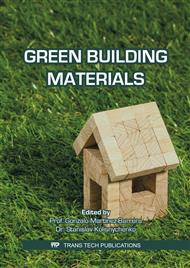p.51
p.59
p.67
p.75
p.81
p.91
p.99
p.107
p.113
Mechanical Efficiency and Biomechanical Performance of Innovative Sandwich-Like Composite Wall Biopanels - A Structural Alternative for Constructions in High-Risk Seismic and Windy Regions
Abstract:
The great potentials of wood species have not yet been fully tapped in Ecuador in order to propose feasible and eco-friendly alternatives that allow reducing/replacing conventional building materials. This investigation aims to determine the physical-mechanical properties of lightweight bidirectional sandwich-like composite wall panels made of bamboo (Dendrocalamus asper), melina (Gmelina arborea) and balsa (Ochroma pyramidale). To fulfil this purpose, 80 samples from four prototype biopanels were tested in accordance to the current American Society for Testing and Materials (ASTM) standards. The experimental results were validated and compensated by performing a total of 79 finite element analyses (FEA) that in turn allowed evaluating and analyzing both the mechanical efficiency and the biomechanical performance of the proposed biopanels. The results in this investigation showed sandwich-like composite wall biopanels with an enhanced mechanical efficiency that is up to nine times higher than steel, concrete, aluminum, wood and bricks. Results from the biomechanical analyses confirm the practical utilization of the proposed biopanels in low-rise and mid-rise buildings (i.e. between two and ten stories) located in high-risk seismic and windy regions. Thus, its implementation in the actual construction system will definitely implicate important upgrades in terms of structural optimization and sustainable practices. Indeed, the proposed wall biopanels are meant to be used in the rebuilding process of the dramatically affected areas during the 2016 Ecuador earthquake.
Info:
Periodical:
Pages:
81-88
Citation:
Online since:
May 2020
Price:
Сopyright:
© 2020 Trans Tech Publications Ltd. All Rights Reserved
Share:
Citation:



